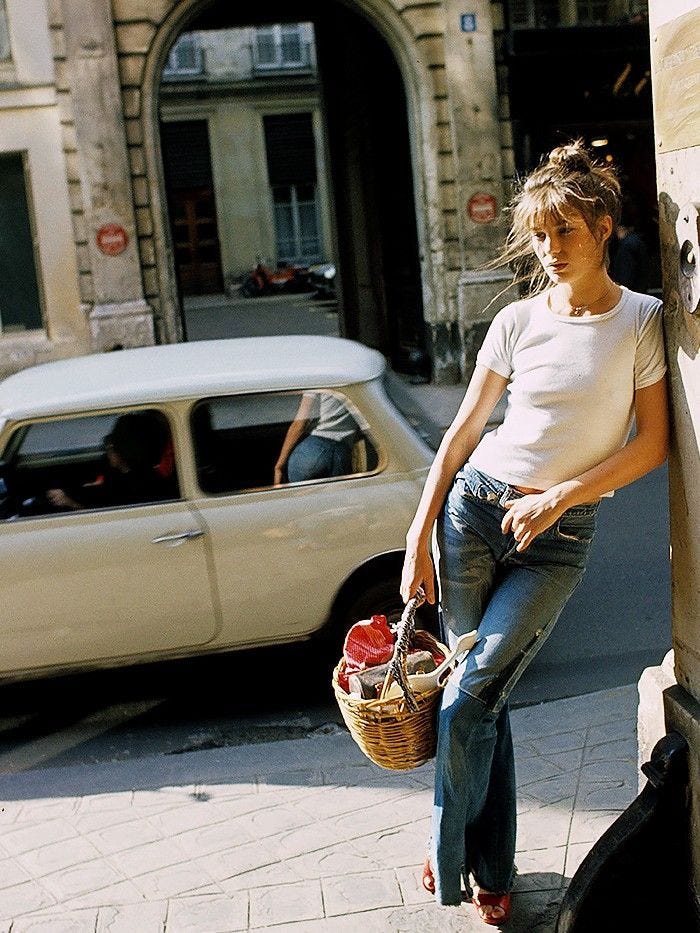Vintage and the Circular Economy
This week’s newsletter is dedicated to vintage and the circular economy. Shopping for second-hand items isn’t only en vogue, but it’s significantly better for the planet. In fact, shopping for vintage greatly reduces our carbon emissions and overall footprint.

I started shopping for vintage when I was 14. Old films and 70s bands informed my style, and I was on the search for the perfect, lived-in leather jacket. I believed with full certainty that a retired rock and roller’s jacket had more grit, more soul than what was readily available at Forever 21 (and that alone could help me fully express my teen-angst and musical preferences).
In high school, I spent all my weekends at flea markets and vintage shops. At the time, I shopped vintage for fiscal reasons (an allowance) and the thrill of a great hunt, knowing that the dress I scored was unique and well-earned. There was something so gratifying at that moment when you come across an item you love: some forlorn floral dress sun-bleached on the racks at the Rose Bowl Flea Market.
I started a vintage site called The Caravan in my first year of college; The idea started when the images I published on Myspace received some interest in where I sourced my wardrobe. At The Caravan, I stocked 60s lace slips and archival YSL, a side hustle that gave me the financial freedom to move out of my parent's house at 18.
Fast forward to today, my most cherished items are one-offs I've sourced from brocantes, flea markets, and second-hand shops around the world: From a patent pair of Chanel flats from the 70s to a French market basket that travels with me to the farmers market. The nostalgia even expands to furniture and objects: a Charlotte Perriand table I searched for weeks, to a hand-carved sculpture from a Florentine street-side vendor.
Vintage shopping gave me the liberties to explore and express my personal style at all stages, from my scrappy student days to the present. It’s a process less fixed on trends and more about searching for intrinsic value. It attests to timelessness, quality, and a mindful approach to the preservation of garments. Vintage and second-hand shopping is the anti-fast fashion, and while it’s a time-intensive process, it’s also a rewarding one.
Here’s my top 10 list of the week, on why buying vintage is the “greenest” way to shop, and where to source pre-loved items online and in-real-life.
1. Inside an episode of the Patriot Act hosted by Hasan Minhaj, Minhaj reveals that if consumers bought one used item this year instead of new, it saves nearly six pounds of c02 emissions, which equates to removing half a million cars off the road for a year. In the episode titled “The Ugly Truth of Fast Fashion”, researchers concluded that investing in long term pieces and cycling them through your wardrobe for at least nine months significantly reduces your carbon footprint. The key takeaway is while we can't eliminate our need for novelty overnight, consider vintage if opting for a trend.
2. My go-to resources for second-hand luxury and contemporary labels are The Real Real and Vestiaire & Co. Both sites offer a full breadth of inventory from current and past collections in pristine condition — from Chanel, The Row, Brock Collection, Khaite, all within an accessible price range.
3. One event I look forward to in Los Angeles and New York is A Current Affair, a marketplace my friend Richard Wainwright started to organize the vintage community. A Current Affair assembles the best retailers and private dealers into one space, showcasing the greatest selection in vintage clothing, jewelry, and accessories.
6. Etsy is an excellent market place for home goods and craft items, and I’ve sourced everything from Japanese pottery to wood sculptures off the site.
7. The best sites to find collectible furniture are 1st Dibs, Chairish, and Pamono. These sites stock original productions of designer mid-century chairs, tables sideboards, and beyond.
8. Object. Vintage is a New York City-based vintage bazaar that simplifies "the hunt" by curating second-hand retailers into one app.
9. One of the lifestyle markers of living in Los Angeles was the accessibility to great flea markets on the weekend. Flea markets were congregating areas and an excellent way to spend a Sunday outdoors. Head to Rosebowl in Pasadena, Long Beach Flea, or Alameda Antiques in San Francisco.
10. Pandora Sykes’ feature on Man Repeller about vintage style is a great testament to expressing a unique POV in personal style when you’re not dressed head to toe in high street trends.
Happy hunting, see you next week.



